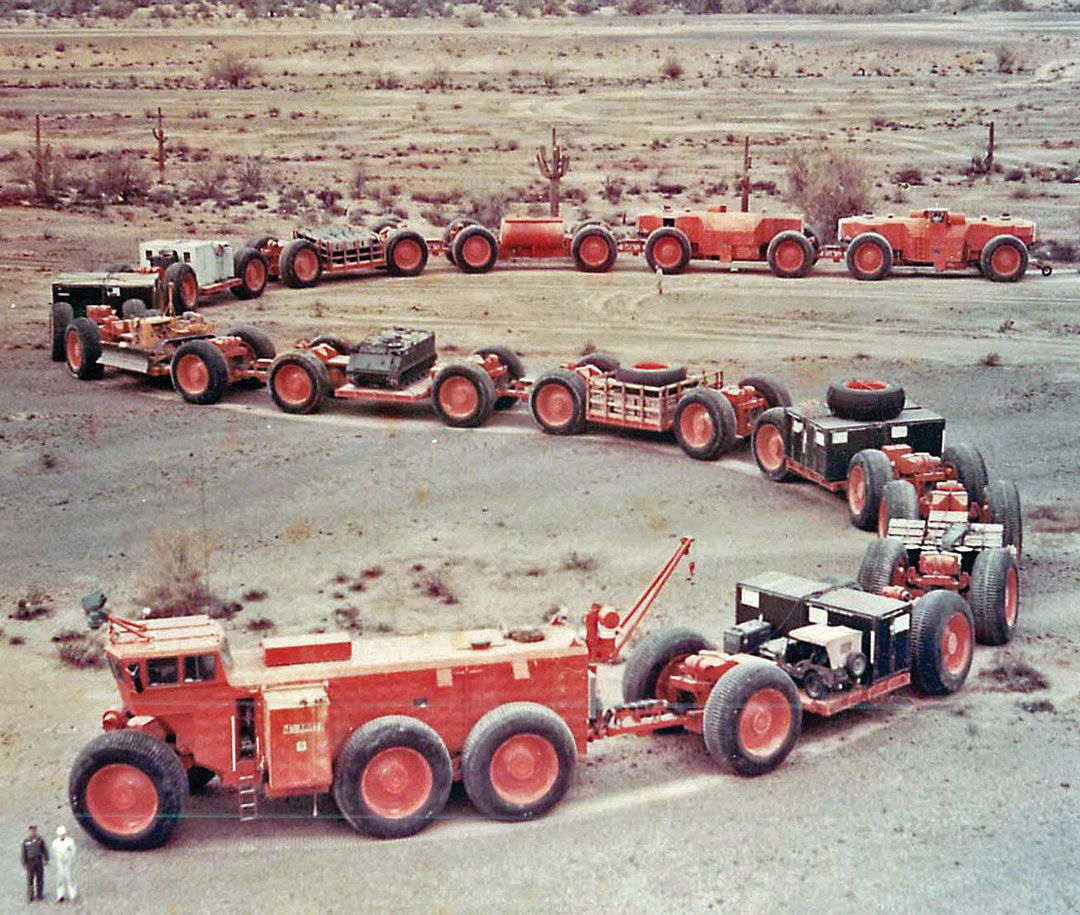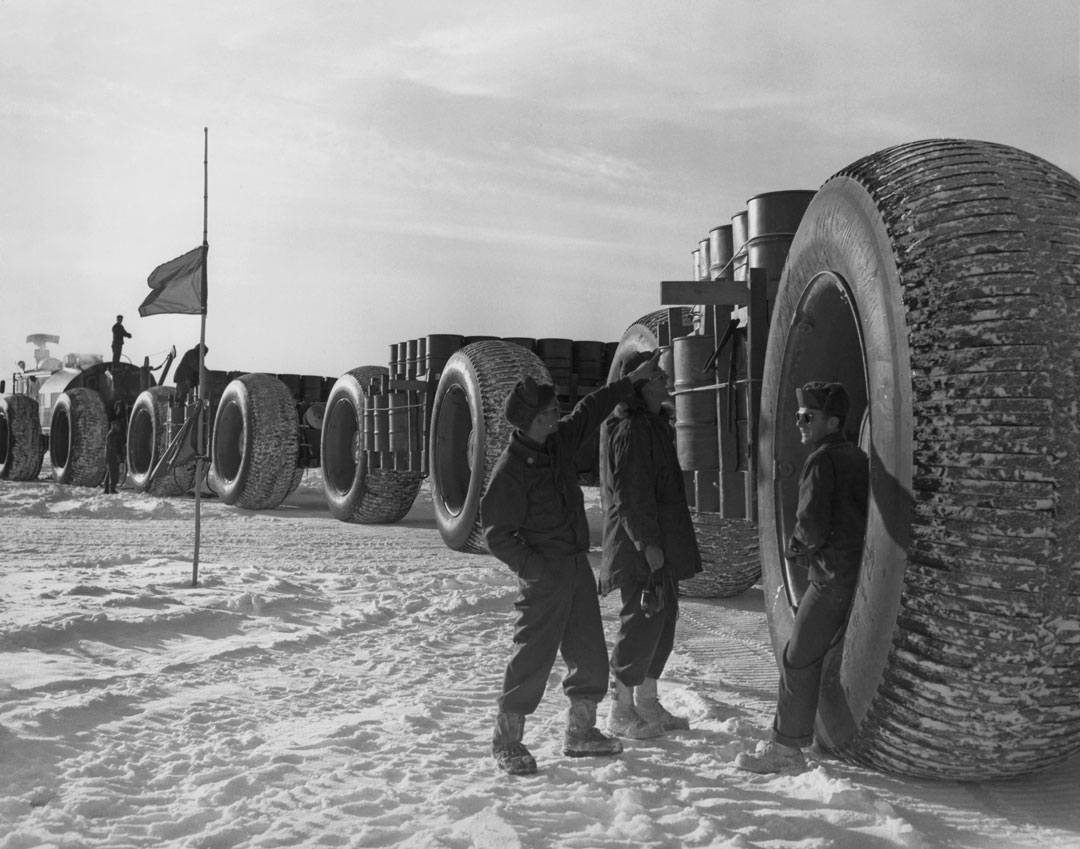
WHAT A GEM: The U.S. Army ground effects machines, or GEM, was a hovercraft powered by two aircraft engines driving ducted fans and was capable of traveling over land or water—even if it may have been a little hard to steer. (Photo courtesy of the U.S. Army Transportation Museum, Fort Eustis, Virginia)
In 1961, in the heat of the Cold War, the U.S. Army’s view of materiel for transport—air or ground—wasn’t that different from today: The best tech wins.
by Stephen Stark
Among the Army’s top priorities today are future vehicles for both land and air. Whatever the fruits of the Next Generation Combat Vehicle and Future Vertical Lift programs look like, it is probably a safe bet that they won’t look anything like the futuristic vehicle highlighted in the January 1961—only the second—edition of Army Research and Development Newsmagazine, the predecessor to this publication.
On page 8, we learn about DOD’s research into “ground effects machines.” At the time, all of the services were keenly interested in the possibilities inherent in hovercraft. In the late 1950s, the Curtiss-Wright Corp. introduced its Model 2500 Air Car, which sought to shake up the American automobile market with a family-car equivalent hovercraft. Reflecting the “tremendous interest” in what DOD was calling “ground effects,” or (apparently) hovering, the U.S. Army Transportation Corps acquired a pair of the machines, which were powered by two aircraft engines driving ducted fans.
The car rose off flat ground—or water—on a cushion of air and a surrounding dust or vapor cloud, and allegedly traveled as fast as 60 miles per hour. The vehicle steered with louvered vents in its sides that could push it right or left, though it’s not hard to imagine a driver losing control of the contraption at higher speeds. It did less well on rougher terrain. Perhaps coincidentally, the design of the Curtiss-Wright vehicle seems to share a good deal with bumper cars.
The vehicle didn’t gain much traction with the American public, nor with the U.S. Army, which was also working on, among other things, a different sort of hovercraft—the helicopter. That technology had been kicking around nearly as long as the airplane, if you don’t count Leonardo da Vinci’s conceptual drawings.
LUMBERING BEAST
But the Army, then as now, had more irons in the fire than just the ground-effects machine. Two pages later, we learn that the Army was also looking into using a nuclear reactor to power its Overland Train.
To the contemporary eye, the Overland Train might seem as wacky as the Air Car. The magazine’s accompanying image, of what appears to be a truck pulling trailer after trailer after trailer, seems almost patently absurd. But that image offers no sense of the scale of the machine. That may have been because the Overland Train was probably well-known to readers. Indeed, it was something of a midcentury engineering marvel that had even appeared in LIFE Magazine.
R.G. LeTourneau Inc., a Texas maker of heavy machinery, created the Tournatrain to haul timber from remote wilderness areas where there were no roads and no infrastructure. The Army wanted to do the exact opposite—haul tons of gear into wilderness where there was essentially nothing. This was in service to the DEW line. DEW was an acronym for distant early warning. If the Soviets launched a nuclear attack against the United States, the shortest distance for their bombers to travel would be over the North Pole.
If the United States wanted an early warning of such an attack and the ability to strike back with its own bombers and intercontinental ballistic missiles, it needed to move many hundreds of tons of gear and infrastructure to the inside the Arctic Circle. Creating the DEW line meant that the government needed to have sensors where there had never been any.
Back at the beginning of 1961, it wasn’t yet three years since the U.S. had launched its first artificial satellite, much less a GPS network. So the country needed boots on the ground along with radar stations in remote locations to monitor for potential nuclear surprise attacks. The DEW line was also intended to warn of invasion by sea and land.
That meant that the Army needed a means to haul all of that materiel to places with no roads or infrastructure and nothing but wilderness. When the U.S. Army Transportation Research and Development Command (TRADCOM) got a demonstration of LeTourneau’s VC-12 Tournatrain, the logging version of the trainlike truck, it probably seemed like the Army’s best bet.

MEANT FOR BIG JOBS: LeTourneau’s TC-497 Overland Train Mark II boasted a three-story tall, six-wheeled cab and 10-foot-tall tires. (Source: Wikipedia)
MONSTER TRUCKS
Based on a diesel locomotive, LeTourneau’s overland train was powered by a 500-horsepower diesel engine that didn’t drive the wheels, but powered a generator to provide electricity to each hub, which had its own motor. The Army never bought the VC-12, but TRADCOM funded the development of another LeTourneau vehicle, the TC-264 Sno-Buggy, a vehicle that resembles the lovechild of a semi-truck tractor and a farm tractor: two wheels in front and eight in back, paired in twos, and with 10-foot-tall tires. It had a monster footprint—a sufficient tire-to-vehicle-weight area to enable it to move across tundra and snow. It was powered by the same engine that powered the Lockheed P-38 and many other World War II aircraft. Meanwhile, LeTourneau was also developing the VC-22 Sno-Freighter for Alaska Freightlines and the Army. Both were working with Canada on the development of the DEW line.
The Army was aiming for more. The Army Transportation Corps asked LeTourneau to combine the Sno-Buggy with the Tournatrain, which resulted in a vehicle that the Army called the Logistics Cargo Carrier (LCC 1), of which it took possession in the mid-1950s. Capable of hauling 45 tons, the vehicle was successful enough that the Army wanted one that was bigger and better—an overland train that could be as long as the Army needed it to be.
LCC 1’s successor, the eventual Overland Train, was a monster version of the LCC 1. LeTourneau’s TC-497 Overland Train Mark II boasted a three-story tall, six-wheeled cab—in images, it’s reminiscent of an air traffic control tower—and also had 10-foot-tall tires. It could haul 150 tons, measured nearly three football fields in length, and could travel about 400 miles at about 20 miles per hour.
The idea for a nuclear powerplant for the vehicle in 1961 made sense: The vehicle was enormous and adding more power would enable endless expansion. A nuclear power plant could generate power for the electric motors that drove each of the wheels indefinitely.
By that time, the Army had been looking at small-scale nuclear power plants, and the idea of nuclear power may have been part of a larger strategy. In the May 1961 issue, Lt. Gen. Arthur Trudeau, then the Army chief of research and development, noted that “Unfortunately, the extent to which nuclear plants can be miniaturized appears to be limited—and the cost of reactors is still too high. Yet, we can approach the optimum if we utilize a nuclear-powered, cross-country vehicle comparable to the overland train as a mobile supply point. (See Army R&D Newsmagazine, January, Page 10.)”
VERTICAL LIFT TAKES OFF
Alas, it was not to be. LeTourneau delivered the final version, with gas turbine engines, to the Army at Yuma Proving Ground, Arizona, where it stayed. According to online sources, the cab is still there. The rest was sold off.
As to its predecessor, according to an article in the UK’s Daily Mail, “The Sno-Buggy’s massive tires were later used on the famous Bigfoot monster truck, after the owner bought them in a Seattle junkyard for $1,000.”
The thing that killed the overland train wasn’t any failure of the Army, the vehicle or LeTourneau, which is now part of Komatsu LTD. It was the Army’s simultaneous work in vertical lift. The Sikorsky CH-54 Tarhe twin-engine heavy-life helicopter could do the job that the Overland Train was intended to do, but could do it better, cheaper and faster. Its civilian counterpart, the S-64 Skycrane, first flew in 1962.

THE BIGGEST WHEEL: A LeTourneau LCC-1 Sno-Train carrying supplies near Camp Century, an Arctic United States military scientific research base in Greenland, June 1959. The base is a network of trenches dug out of the snow and ice and lined with corrugated steel arches. Camp Century was later found to be a cover project for Project Iceworm, a secret plan to install nuclear missile launch sites under the Greenland ice sheet. Both Camp Century and Project Iceworm were abandoned in 1967 when it emerged that the Greenland ice was not stable enough for the structures to be viable in the long term. (Photo by U.S. Army/Pictorial Parade/Archive Photos/Getty Images)
Read the full article in the Fall 2020 issue of Army AL&T magazine.
Subscribe to Army AL&T News – the premier online news source for the Army Acquisition Workforce. ![]() Subscribe
Subscribe







